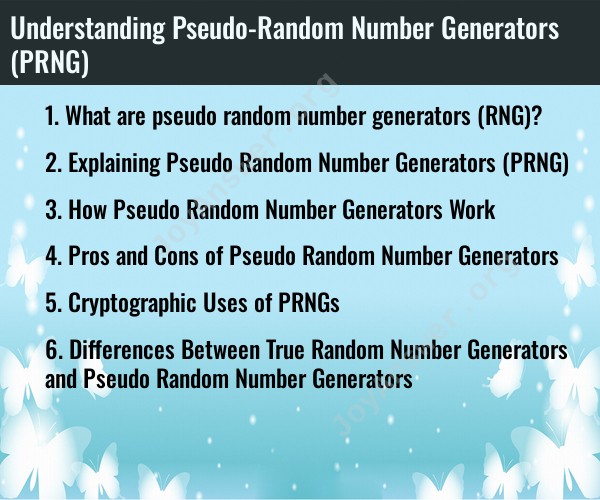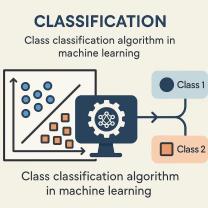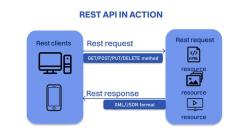What are pseudo random number generators (RNG)?
Pseudo-Random Number Generators (PRNGs), often referred to as simply Random Number Generators (RNGs), are algorithms or mathematical functions that generate a sequence of numbers that appear to be random, but are not truly random. These algorithms use an initial value called a seed to produce a sequence of numbers that is deterministic and reproducible. In other words, if you provide the same seed to the same PRNG, it will produce the same sequence of numbers.
Here are key characteristics and concepts related to PRNGs:
Deterministic Nature: PRNGs are entirely deterministic, meaning that if you know the initial seed, you can predict all the subsequent numbers in the sequence.
Reproducibility: The same PRNG with the same seed will always produce the same sequence of numbers. This property is valuable in computer simulations and testing because it allows for reproducibility of results.
Periodicity: PRNGs have a finite period, which is the length of the sequence before it repeats. When the sequence reaches the end of its period, it starts over from the beginning.
Pseudo-Randomness: The numbers generated by PRNGs are statistically random enough for many practical purposes but are not truly random. They are determined by the PRNG algorithm and seed.
Initialization (Seed): PRNGs require an initial seed value to start generating numbers. The choice of the seed can significantly affect the resulting sequence. Using the same seed produces the same sequence every time, while changing the seed will produce a different sequence.
Uniform Distribution: Good PRNGs aim to produce numbers that follow a uniform distribution, meaning each number in the range has an equal likelihood of being generated.
Applications: PRNGs are widely used in computer science, simulations, cryptography, gaming, and many other fields where randomness is required. They provide a practical way to introduce randomness into computer-based processes.
It's important to note that while PRNGs are useful for many applications, they are not suitable for cryptographic purposes where true randomness is essential. Cryptographically secure random number generators (CSPRNGs) are designed to resist various forms of attacks and provide a higher level of randomness and unpredictability.
Common programming languages and libraries often include built-in PRNGs for various use cases. In Python, for example, the random module provides functions for generating pseudo-random numbers. It's crucial to select an appropriate PRNG for your specific application and understand its characteristics to ensure the generated numbers meet the required level of randomness and unpredictability.
Explaining Pseudo Random Number Generators (PRNG)
A pseudo-random number generator (PRNG) is an algorithm that generates a sequence of numbers that appear to be random, but are actually deterministic. This means that the sequence is not truly random, but it is unpredictable enough for many purposes. PRNGs are widely used in computer applications, including cryptography, simulation, and gaming.
How Pseudo Random Number Generators Work
PRNGs work by using a mathematical formula to generate a sequence of numbers. The formula is typically based on a seed value, which is a starting point for the sequence. The seed value is usually chosen to be a large, unpredictable number.
The formula then iteratively applies a mathematical operation to the seed value to generate the next number in the sequence. The operation is typically designed to be chaotic, meaning that small changes in the seed value can lead to large changes in the sequence.
Pros and Cons of Pseudo Random Number Generators
PRNGs have several advantages over true random number generators (TRNGs). They are much faster than TRNGs, and they can be easily implemented in software. Additionally, PRNGs can be seeded with a specific value, which allows for reproducible sequences.
However, PRNGs also have some disadvantages. They are not truly random, and their sequences can be predictable if the seed value is known. Additionally, PRNGs can be susceptible to certain types of attacks, such as cryptanalysis.
Cryptographic Uses of PRNGs
PRNGs are widely used in cryptography. They are used to generate keys for encryption and decryption algorithms, as well as to generate random values for other cryptographic operations.
PRNGs are also used in other applications that require random numbers, such as computer simulations and gaming.
Differences Between True Random Number Generators and Pseudo Random Number Generators
A true random number generator (TRNG) is a device that generates a sequence of numbers that are truly random. This means that the sequence is unpredictable and cannot be reproduced. TRNGs are typically based on physical processes, such as radioactive decay or thermal noise.
PRNGs, on the other hand, are deterministic algorithms that generate a sequence of numbers that appear to be random. However, the sequence is not truly random, and it can be reproduced if the seed value is known.
TRNGs are more secure than PRNGs, but they are also more expensive and slower. PRNGs are more practical for most applications, but they should be used with caution in applications that require high security.
Here is a table summarizing the key differences between TRNGs and PRNGs:
| Feature | TRNG | PRNG |
|---|---|---|
| Predictability | Truly random | Deterministic |
| Reproducibility | Not reproducible | Reproducible if seed value is known |
| Security | More secure | Less secure |
| Speed | Slower | Faster |
| Cost | More expensive | Less expensive |












